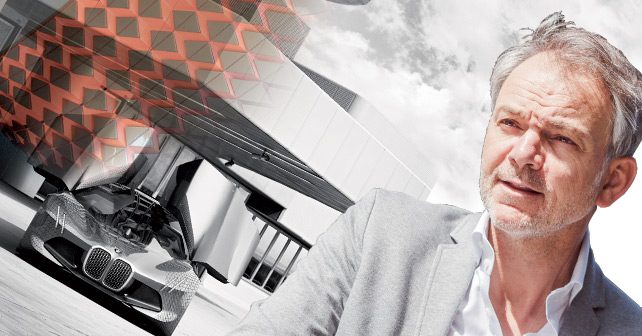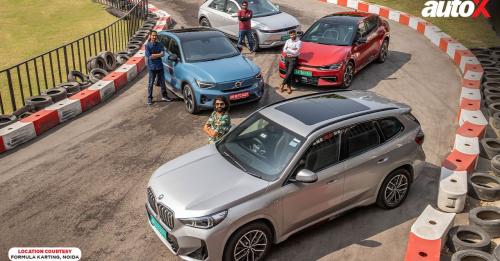Experimenting with the unconventional in order to bring change on a larger scale – that’s the philosophy of Adrian van Hooydonk, Design Head for BMW.
Learning from the past, looking to the future, embracing tradition, but ensuring innovation – this is what designers aim at, and, undoubtedly, lose sleep over. Why? Well, because if there’s one thing that can’t be neglected, it’s brand identity – especially if you’re a marque brand like BMW with a 100-year history. And, of course, standing still marks the death knell for any company.
These are some of the issues debated everyday by Adrian von Hooydonk – who, since 2009, has led the design team at the Bavarian automaker. In that time, BMW has even introduced a sub-brand that caters to electric mobility. At the same time, it’s also continued to develop its traditional sedans – such as the 7 and 5 Series. But Hooydonk doesn’t see a contradiction in the approach towards both sets of vehicles. “We did favour more futuristic alternatives for the i3 and i8,” he explains. “We thought that a big technological innovation should correspond to taking a definite step ahead in terms of design. And it’s clear that whenever you see something so advanced on the road, other cars end up looking more normal.”
The experience gained, however, isn’t meant to remain isolated. “We believe that the diffusion of ‘i’ will lead to a modernisation of the whole range and speed up the process of change.” Customers will gradually become ready to accept this evolution, which is on par with the rapid and dynamic pace of technological change in this day and age.
“When we launched the concept Vision Efficient Dynamics in 2009, which later on became the i8,” Hoydoonk says, “we generated a lot of surprise, within the company and amongst our most traditional clientele. Yet, we showed that this kind of mobility can be sporty and emotional. Since then things have developed quite fast. I believe that the i8 prototype allowed us to turn the page, and helped the Board understand that our customers would love this sort of technology. For us, it led to more freedom in terms of design.”
Leave no niche unturned
That freedom is, of course, also thanks to the availability of new materials. “In the electric cars,” Hooydoonk explains, “we availed a very wide door opening angle – possible due to the use of carbon fibre, which is light but very rigid. And carbon, even if it’s not visible, has already been adopted for the production of other models. For instance, for the structure underlying the doors of the 7 Series.”
At BMW, they believe that in future there’ll be a consistent use of a mix of materials – with a combination of carbon, steel and aluminium. In an era characterised by the spreading of the SUV and crossovers of different sizes, in Munich they firmly believe in the importance of market niches. “If we look back at our history,” the designer explains, “we do understand how the company has continuously kept reinventing itself. It started with manufacturing planes and motorbikes – then shifted to cars. It created unique body styles, such as the hatchback – launched along with the 2002, when nobody else could have imagined it at the time – and the X6, which was welcomed with scepticism, and then imitated by other manufacturers. It’s a way to offer more choice to our customers, and cater to their different lifestyles.”
“There is no reason to design one car for a businessman and another for a sportsman, since the same person could embody both roles. This is our duty – to always look for something different.”
Different Solutions
The cabin of a car plays a very central role in the quest for innovation, with special emphasis placed on the human-machine interface – which continues to get increasingly complex. Even in this field, BMW led the way with the iDrive system. Today, however, we’re witnessing the spreading of touch-screen devices – a practice that tends to take the driver’s attention away from the road.
“We find ourselves at an intersection,” said van Hooydonk in this regard. “On board of the 7 Series, we’ve used touch-screen devices of course, but also voice commands, hand signals, as well as dials. In the future, commands that are based on voice recognition will improve – it’s just a question of computing power. But I believe that these devices will coexist with touch screens, as they’re very effective in the case of some functions.”
“We’ve got used to zooming into a map using our fingertips. These are gestures that customers would want to carry over to the cabin of their cars as well. But there are other operations, like looking up your phone book, for which the touch screen hasn’t proved to be particularly effective. And so we’re likely to move towards the coexistence of different solutions.”
And what about the steering wheel – is it meant to disappear? On board the Vision Next 100 concept, the driver can encase it within the dashboard – leaving the task of driving to the myriad of on-board computers that are part of the car’s management systems. According to Van Hoydoonk, “If cars are going to become autonomous, maybe within a ten-year span, BMW will always leave it to its customer to choose when to drive and when to rely on the artificial intelligence of their vehicle. We do believe in individual mobility, and in the freedom granted by it. Therefore, our cars will always be equipped with a steering wheel. Small in size and flat like the one featured in the Vision Next 100 – similar to the ones on board our DTM race cars, and consequently ideal to integrate within the dashboard. But it’ll always be there.” That’s good to hear, we have to say!
BMW glimpses into the future with the Vision Next 100 concept, which is built with innovative and intelligent materials. It even features a retractable steering wheel.
The Vision Next 100 concept pre-empts BMW’s car of the future, according to a team that comprises of Karim Habib (Style Director at BMW), Adrian van Hooydonk (Design Head), and Domagoj Dukec (Exterior Designer at BMW).
Currently there’s no continuity between the innovative style embodied by the i3 and i8 and the more traditional models such as the 7 Series. But these differences will reduce in the coming years. Meanwhile, on the top right, are sketches of the interior of the Vision Next 100 concept – developed in order to celebrate BMW’s centenary.
© Riproduzione riservata
Also read: Centenary celebrations: BMW turns 100





































Write your Comment